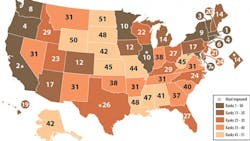Massachusetts Edges Out California as Most Energy-Efficient State
Energy efficiency measures continue to flourish in states across the country, with several states—including California, Maryland, Illinois, Texas and the nation’s capital, Washington, DC—taking major steps that improved their scores in the ninth annual edition of the State Energy Efficiency Scorecard, released today by the American Council for an Energy-Efficient Economy (ACEEE). The State Scorecard ranking of the states is issued annually with the support of the US Department of Energy. This year, DOE Deputy Assistant Secretary for Energy Efficiency Kathleen Hogan participated in the release of the ACEEE report.
Available online at http://aceee.org/state-policy/scorecard, the following are key findings of the 2015 State Scorecard:
- The top 10 states for energy efficiency are Massachusetts, California, Vermont, Rhode Island, Oregon, Connecticut, Maryland, Washington, and New York, with Minnesota and Illinois tied for 10th place. Massachusetts retains the top spot for the fifth consecutive year based on a strong commitment to energy efficiency under its Green Communities Act. In California, requirements for reductions in greenhouse gas (GHG) emissions, major efforts to achieve energy efficiency in schools, and implementation of a cap-and-trade program earned the state several more points this year, putting it only a half-point behind Massachusetts in the state rankings.
- A solid 20 states rose in the State Scorecard rankings. California, a leading state, is also one of the most improved states this year. Maryland, Illinois, the District of Columbia, and Texas also deserve recognition for improvement over the past year. Maryland increased its commitment to energy efficiency in 2015 by establishing new, more aggressive energy savings targets for utilities. Illinois is one of the first states to adopt the newest building energy codes, and has increased the amount of energy efficiency available to utilities through procurement agreements with the Illinois Power Agency. Like Illinois, Texas has been aggressive in adopting the latest building energy codes, and has also taken notable actions to ensure code compliance across the state. The District of Columbia is among the most improved for the second year in a row, due to its progress across a number of policy areas and the ramping up of DC Sustainable Energy Utility programs.
- Overall, 16 states fell in the rankings this year, due to such factors as policy or program rollbacks or failure to keep pace as other states expanded efficiency efforts. The five states most in need of improvement (starting with dead last) are: North Dakota, Wyoming, South Dakota, Louisiana, and Mississippi, although new efficiency programs in Louisiana and Mississippi mean these states may not be in the bottom for much longer. While not in the bottom five states, New Mexico dropped the farthest in 2015, losing four points and falling six positions from 25th to 31st in the rankings. This is due in part to the state’s failure to adopt energy building codes beyond the 2009 requirements. Many of the states falling behind are not increasing energy savings year after year, and are therefore being outpaced as other states ramp up programs to meet higher savings targets.
ACEEE executive director Steve Nadel said: “As states move to frame their plans under the federal Clean Power Plan, this year marks a tipping point for energy efficiency. State policies are increasingly encouraging utilities to invest in cost-effective efficiency, prompting them to adopt new business models that align their interests with those of customers and policymakers. We can see this taking hold in the 20 states that improved their Scorecard rank in 2015. Utilities across the United States invested more than $7 billion in energy efficiency over the past year alone.”
Other Key Findings
The State Scorecard assesses state policies and programs that improve energy efficiency in our homes, businesses, industries, and transportation systems. It considers the six policy areas in which states typically pursue energy efficiency: utility and public benefits, transportation, building energy codes and compliance, combined heat and power (CHP), state government–led initiatives around energy efficiency, and appliance and equipment standards.
Additional topline findings include:
- Savings from electricity efficiency programs in 2014 totaled approximately 25.7million megawatt-hours (MWh), a 5.8% increase over last year. These savings are equivalent to about 0.7% of total retail electricity sales across the nation in 2014. Gas savings for 2014 were reported at 374 million therms (MMTherms), a 35% increase over 2013.
- The leading states in utility-sector energy efficiency programs and policies in 2015 are Massachusetts, Rhode Island, and Vermont. These are the same three states that topped this category in 2014. With long records of success, all three continued to raise the bar on cost-effective programs and policies.
- California, Massachusetts, and New York led the way in energy-efficient transportation policies. Massachusetts promoted smart growth development in cities and municipalities through state-delivered financial incentives. New York is one of the few states in the nation to have a vehicle-miles-traveled reduction target.
- The leading states in building energy codes and compliance in 2015 are California and Illinois. Only four states, California, Illinois, New Jersey, and Maryland have adopted the latest commercial and residential building energy codes without significant weakening amendments.
- Massachusetts, Maryland, and California were the highest ranked for combined heat and power policies.
- California, Illinois, Minnesota, and New York led the way in state government initiatives.
Methodology
As in past years, the ninth edition of the State Scorecard ranks states on their policy and program efforts, not only assessing performance but also documenting best practices and recognizing leadership. The State Scorecard provides an annual benchmark of the progress of state energy efficiency policies and programs. It encourages states to continue strengthening their commitment to efficiency, thereby promoting economic growth and environmental benefits.
